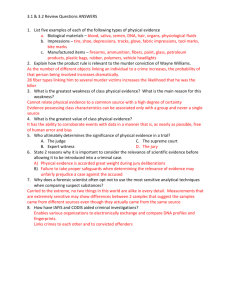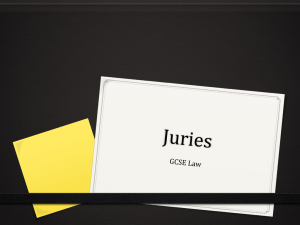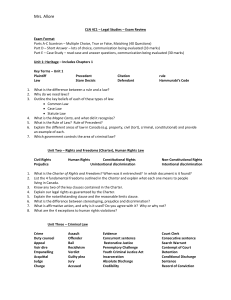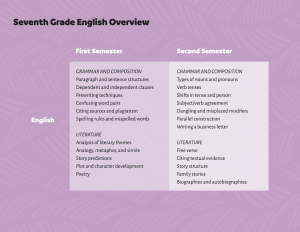US Government
advertisement
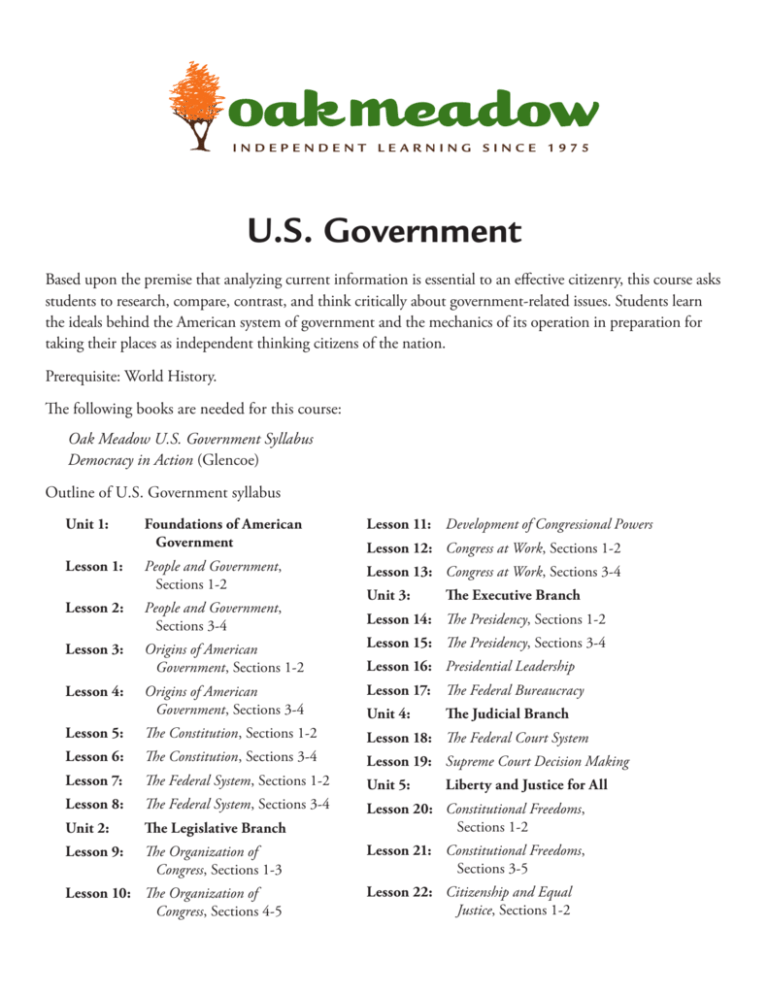
6 Oak Meadow High School Curriculum Overview INDEPENDENT LEARNING SINCE 1975 U.S. Government U.S. Government Based on the premise that analyzing current information is essential to an effective citizenry, this course asks students to research, compare, contrast, and think critically Based upon the premise that analyzing current information is essential to an effective citizenry, this course asks abouttogovernment-related issues. and Students theabout idealsgovernment-related behind the American students research, compare, contrast, think learn critically issues.system Students learn the of ideals behind the the American systemofofits government and theare mechanics of its operation in preparation for government, mechanics operation, and then encouraged to take their taking theirasplaces as independent thinking citizens the nation. places independent thinking citizens in theofcountry. The following books are required for this course: Prerequisite: World History. The following books are needed this course: Syllabus Meadow U.S.for Government • The Oak in Government Action by richard • Democracy Oak Meadow U.S. Syllabus C. remy; Glencoe/McGraw-Hill, 2003 Democracy in Action (Glencoe) Outline of the U.S. Government Syllabus: Outline of U.S. Government syllabus Unit 1: Foundations of American Government Lesson 11: Development of Congressional Powers Lesson 1: People and Government, Sections 1-2 Lesson 13: Congress at Work, Sections 3-4 Lesson 2: People and Government, Sections 3-4 Lesson 3: Origins of American Government, Sections 1-2 Lesson 15: The Presidency, Sections 3-4 Lesson 4: Origins of American Government, Sections 3-4 Lesson 17: The Federal Bureaucracy Lesson 5: The Constitution, Sections 1-2 Lesson 18: The Federal Court System Lesson 6: The Constitution, Sections 3-4 Lesson 19: Supreme Court Decision Making Lesson 7: The Federal System, Sections 1-2 Unit 5: Lesson 8: The Federal System, Sections 3-4 Unit 2: The Legislative Branch Lesson 20: Constitutional Freedoms, Sections 1-2 Lesson 9: The Organization of Congress, Sections 1-3 Lesson 21: Constitutional Freedoms, Sections 3-5 Lesson 10: The Organization of Congress, Sections 4-5 Lesson 12: Congress at Work, Sections 1-2 Unit 3: The Executive Branch Lesson 14: The Presidency, Sections 1-2 Lesson 16: Presidential Leadership Unit 4: The Judicial Branch Liberty and Justice for All Lesson 22: Citizenship and Equal Justice, Sections 1-2 U.S. Government Lesson 23: Citizenship and Equal Justice, Sections 3-5 Lesson 24: Law in America Unit 6: Participating in Government Lesson 25: Political Parties Lesson 26: Elections and Voting Lesson 27: Interest Groups and Public Opinion Lesson 28: The Mass Media Unit 7: Public Policies and Services Lesson 29: Taxing and Spending Lesson 30: Social and Domestic Policy Lesson 31: Foreign Policy and Defense Unit 8: State and Local Government Lesson 32: Structure and Function of State Government, Sections 1-2 Lesson 33: Structure and Function of State Government, Sections 3-4 Lesson 34: Structure and Function of Local Government Unit 9: Political and Economic Systems Lesson 35: Political Systems in Today’s World Lesson 36: Development of Economic Systems Oak Meadow High School Curriculum Overview Lesson 24: Chapter 15, Sections 1-3 (pp. 422-449) Chapter 15: Law in America The hallmark of our democratic society is that decisions and actions are made according to established laws rather than by arbitrary actions and decrees. Chapter 15 focuses on how civil and criminal laws work to protect citizens and to resolve conflicts in everyday life. Section 1 explains the different kinds of law in the United States. In addition to constitutional law, the United States has statutory law, administrative law, common law, and equity. The section also lists the principles of the American justice system: equal justice under the law, due process of law, the adversary system of justice, and the presumption of innocence. Civil law concerns disputes between two or more individuals or between individuals and the government. Section 2 discusses the four important branches of civil law that deal with contracts, property, family relations, and torts. Then it discusses how civil cases, or lawsuits, are resolved. Section 3 defines crime as an act that breaks a criminal law and causes injury and harm to people or to society in general. It also classifies crimes as petty offenses, misdemeanors, or felonies and then explains the steps in a criminal case. Read Chapter 15, Sections 1-3, pages 422-449 Answer the following questions: 1. Substantive due process has to do with what a law says, while procedural due process has to do with how a law is enforced. Give an example of a law that might violate substantive due process, and explain why it does so. 2. Describe the alternatives to a jury trial that exist for deciding a lawsuit. 3. What benefits and drawbacks does the practice of plea bargaining have for society? 4. How do mediation and arbitration help to relieve an overcrowded court system? 5. Why do citizens in a democracy need to know about the legal system? 6. Explain whether a preliminary hearing or a grand jury proceeding better balances the rights of society and the rights of the accused person. 7. Explain how procedural due process helps to assure Americans of equal justice under law. 8. What role do small claims courts play in the legal system? U.S. 44 Government Oak Meadow U.S. Government Syllabus Choose one of the following projects: a) Collect and study newspaper or magazine clippings that show the American legal system at work. For example, one day’s newspaper might run a front-page article about a lawsuit being brought by a well-known person or against a well-known business; another day might find letters to the editor praising or protesting a proposed change in a local law; an interview with a criminal attorney might appear in a regional or national magazine; and so on. (Alternatively, you can tape such pieces from radio or television broadcasts or obtain them from the Internet.) Select one clipping, summarize its content, and indicate how that content relates to the legal issues discussed in this chapter. b) Study these quotations about the nature and purpose of laws, expressed by famous Americans of the past: x x x “The law is not an end in itself, nor does it provide ends. It is preeminently a means to serve what we think is right.” — William J. Brennan “One with the law is a majority.” — Calvin Coolidge “Our defense is not in armaments, nor in science, nor in going underground. Our defense is in law and order.” — Albert Einstein In a short essay, discuss the meaning of each quotation, relating it to the power of laws and the extent to which laws govern various aspects of American life. c) Create a board game that illustrates the procedures followed in a criminal trial, with the goal of the defendant’s acquittal. Include such factors as the severity of the crime, methods of examining and cross-examining witnesses, and ways in which a player could be ejected from the game (for example, by a plea bargain or a mistrial). d) Arrange to tour a city precinct station or police headquarters, giving special attention to how an arrested person is booked and prepared to be brought before a judge. Share and comment upon your observations. e) Increased media attention to high-profile cases has turned some criminal lawyers into heroes (or villains) of the popular culture. Read a memoir by an attorney connected with the O.J. Simpson case, or another high-profile case. Share insights that the memoir gave you into the system of criminal law in the United States. A few suggested titles are: x x x x Without a Doubt by Marcia Clark and Teresa Carpenter (New York: Viking Press, 1997) Journey to Justice by Johnnie L. Cochran and Tim Rutten (New York: Ballantine Books, 1996) In Contempt by Christopher A. Darden and Jess Walter (New York: HarperCollins, 1996) The Search for Justice: A Defense Attorney’s Brief on the O.J. Simpson Case by Robert L. Shapiro and Larkin Warren (New York: Warner Books, 1996) 10 Lesson 24 Oak Meadow High School Curriculum Overview 45 f) Research and report on the history of the death penalty in the United States. Trace the development of capital punishment from colonial times to today. Present your findings in the form of a presentation that takes a stand for or against capital punishment. Be persuasive and creative when building your presentation. For example, you may wish to create an illustrated timeline of capital punishment or create signs with slogans supporting your opinion. g) Find out how jury duty is handled in your community. These questions may guide your research: x x x x x x Who is eligible to serve on a jury, and how are eligible people located? Who can be excused from jury duty? Under what circumstances can service be postponed? How are jury members summoned, and for how long must they serve? What cases might they hear? Might they be sequestered? How much are jury members paid? Present your findings in a brief report.
